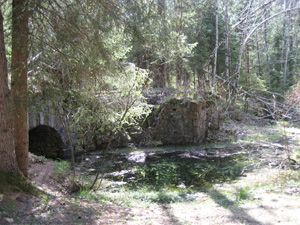| Card n. | Description | Locality | Linked sites |
| 11 | Bagni di Gogna | Auronzo di Cadore, loc. Cimagogna | 29 |
| file .pdf | Industrial Archaeology (AI) | Google maps |
 |
 |
 |
- Description
- How to get there
- Interesting facts
- Bibliography
These springs were already mentioned by Cesare Vecellio at the end of the 16th century for their “sulphurous waters suitable for bathing in”. Their healthy properties were not exploited until the end del 19th century, although a license for the waters to be used for therapeutic purposes had already been granted much earlier, in 1671, to Giacomo Da Ronco from Vigo, and again in 1782 to the physician of Pieve di Cadore, Agostino Sampieri. A private project by Bortolo Larese led, in 1873, to the construction of the first spa establishment there, built in wood and featuring “first class baths” and “second class baths”, which attracted thousands of users. The golden age of the spa area came later, however, in 1888, when other entrepreneurs from the Cadore (Angelo Barnabò and Giovanni Cattaruzza) built a proper spa establishment, featuring 24 bathing cabins, tubs in stone and wood and 30 bedrooms on the first floor, as well as a restaurant, a reception room with a piano, a carriage service, a doctor, newspapers and guides. The baths and showers, with water rich in sulphur and magnesium, were used to treat “catarrhal disorders of the gastrointestinal and genitourinary mucosae, and especially rheumatism of the muscles and joints”. It was a popular destination with holidaymakers, including Queen Margherita di Savoia, as well as with the middle classes of the Cadore, who frequented it from July to September until its popularity declined as a result of the Great War and the fact that spa tourism began to go out of fashion. Today, in the mixed pine, fir and white chestnut wood, it is possible to spot the remains of the stone bathing tubs, rivulets with that give off the typical rotten egg smell and a number of pools with waters rich in iron, magnesium and sulphur that survived the destruction caused by the floods of the nearby Ansiei torrent, which flows into the Piave after just a few metres. In 1997 a series of descriptive panels were positioned as part of a project to safeguard the nature of the area.
Access is from the SS52 trunk road that runs to Auronzo di Cadore, opposite Bar Bob. From there there is a wide path with a bar across it that runs down between Bar Bianco and the headquarters of the Comunità Montana Centro Cadore, or you can take the “della Regina” path that sets out from behind Bar Bianco.
ACCESSIBLE: the springs can be reached on foot along an easy path
MUNICIPALITY: Auronzo di Cadore
PLACE: Cimagogna
GEOGRAPHICAL COORDINATES: X 1765606 – Y 5156778
PROVINCE: Belluno
FILE COMPILED BY: Lonzi
Historical sources from the Cadore area mention curative waters not only in the better-known areas of Lagole di Calalzo and Valgrande di Padola, but also in Venas, Borca and Campo di Cortina d’Ampezzo. Waters of a similar type can also be found in the Alto Agordino area and in Ponte nelle Alpi.
M.S. - A. Guzzon, Cadore. Architettura e Arte, Padua, 2008
G. Secco, La Piave, Cornuda, 1990
G. Ciani, Storia del popolo cadorino (1856) reprinted Treviso, 1940
A. Ronzon, Dal Pelmo al Peralba, Annuario storico cadorino, with a brief illustrated guide to Gogna, the spa baths and the surrounding area, as well as indications on the Cadore area, Lodi, 1896
C. Vecellio, Habiti antichi et moderni, Venice, 1590

